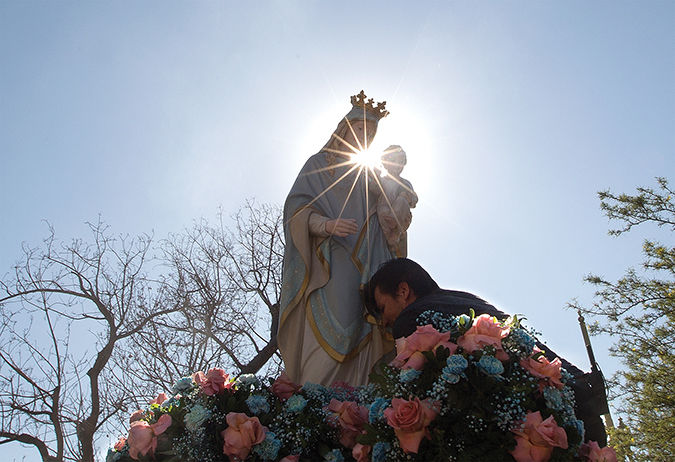When the near-lifed-size statue of the Blessed Virgin cradling a toddler Jesus had passed by, three Hispanic women quickly sidestepped out of their back pews in the Cathedral of Our Lady of the Angels. Getting down on their hands and knees, they collected pink rose pedals and small blue flowers fallen from bouquets at the feet of Mary, borne on the sturdy shoulders of seven men in purple robes.
Knights of Columbus in their own scarlet-trimmed capes formed two columns down the center aisle. At the altar, a line of Aztec dancers, twirling and stomping to the pounding beat of drums, greeted the fourth Grand Marian Procession’s center of attraction.
Now the statue was maneuvered and placed on the right edge of the sanctuary, a silent observer to the Rosary and Votive Mass celebrated by Archbishop José Gomez to follow. Towards the end, the 500-plus congregants sang out, “Immaculate Mary, your praises we sing. You reign now in heaven with Jesus our King. Ave, Ave, Ave Maria. Ave, Ave, Ave, Maria.”
The Sept. 13 afternoon procession and liturgy, organized by the Queen of Angels Foundation, celebrated the founding of El Pueblo de Nuestra Senora de Los Angeles on Sept. 4, 1781, in the name of Our Lady of the Angels. Men and women, teenagers and children gathered at La Placita Church near historic Olvera Street. Claretian Missionary Father Roland Lozano, pastor of the parish where Los Angeles started, blessed the statue.
“She is very, very beautiful, isn’t she?” he said. “She is our mother. She is our queen. And she is always with us, because she loves us so very, very much.”
After, an elderly woman in an electric wheelchair on the sidewalk managed to keep pace with the procession’s lead Los Angeles Fire Department fire truck on North Main Street, passing the Pico House and United States Court House. While the Aztec dancers gave the procession its raw energy, bagpipers from the LAPD Emerald Society of Pipes and Drums provided a more haunting tone.
A military color guard dressed in combat fatigues served as a secular presence alongside religious groups from the Knights and Ladies of Peter Claver, Order of Malta, Order of the Holy Sepulchre, Legatus and Catholic Daughters.
But it was the Los Angeles Catholic School Band, composed of marching bands from all over the archdiocese, that made more than a few Angelenos stop to watch, listen and even smile.
At the Cathedral, during his homily, Archbishop Gomez noted how Franciscan missioners from Mexico via San Diego had first come to Los Angeles during the summer of 1769 — 12 years before the city’s official founding. In that early Portolá expedition were Blessed Father Junipero Serra and Father Juan Crespí.
“I was thinking that these great missionaries, a little more than 200 years ago, were right here working and praying in this neighborhood,” he said. “They were here walking on the grounds where this great cathedral is today.
“So my brothers and sisters, Los Angeles is a holy ground — made holy by the brave sacrifices of the missionaries, sanctified by the Holy Eucharist they celebrated. These special men came to Los Angeles and California to proclaim the Good News, that the new creation begins when we meet Jesus Christ.”

